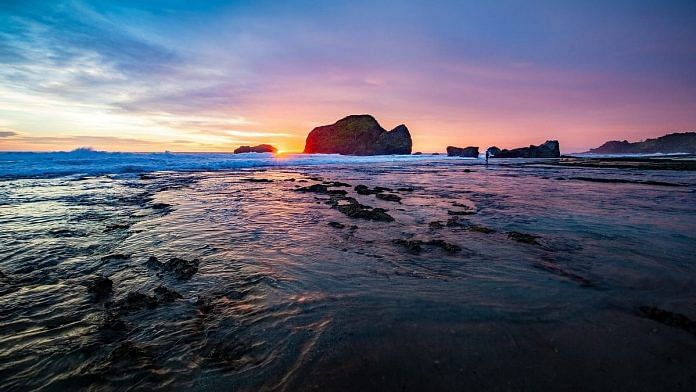Bengaluru: Analysis of data over the past four decades indicates that marine heatwaves (MHW) in the Indian Ocean are increasing in frequency, and this further impacts the Indian monsoon.
The study, led by the Centre for Climate Change Research at the Indian Institute of Tropical Meteorology, Pune, found that in the central region of the Indian subcontinent, summer monsoon rainfall (June-September) will start to reduce, while rains over southwest India will go up, in the future.
This study is the first to have established a link between marine heatwaves in the Indian Ocean and changes in precipitation over the subcontinent. It further found that the western Indian Ocean region generally experienced a higher increase in heatwaves than the north Bay of Bengal.
Marine heatwaves (MHWs) are deadly events that can last for weeks or months, impairing ocean ecosystems, bleaching corals, affecting the fishing industry, and impacting weather. Changes in the monsoon can have potentially devastating consequences, including crop failure.
The study was published in the Journal of Geophysical Research (JGR) Tuesday.
Also read: 2021 monsoon shows impact of climate change. Here’s what it’s doing to kharif crops
Marine heatwave mechanisms
Heatwaves in the ocean are patches of abnormally warm water in an area that persist for a minimum of five days, but mostly extending to weeks or even months. They are caused by a wide range of factors, including building up of ocean currents.
In the aforementioned study, the researchers found that an increase in solar radiation and a drop in cooling from evaporation due to weak winds, led to the formation of the heatwaves in the Indian Ocean.
In the western part of the Indian Ocean, which extends from the Eastern coast of Africa through the Arabian Sea, the weakened winds restricted the movement of warm oceanic currents even more, from the equatorial region up towards the tropics. This further intensified the marine heatwaves here. Between 1982-2018, the western Indian Ocean experienced 66 MHWs, while the Bay of Bengal had 94.
In the western Indian Ocean, we found that the marine heatwaves increased four-fold, during the period studied, said Roxy Mathew Koll, climate scientist and one of the authors of the study. “Over the Bay of Bengal, there’s been a two-to three-fold increase.”
Additionally, MHWs are intensified also from El Niño, the climate pattern where warm oceanic currents originate in the Western Pacific and move towards the east, instead of warmer waters being pushed westward. This in turn affects atmospheric circulation, warming the waters in the Indian Ocean.
The effects of all these factors are compounded by anthropogenic or human-induced global warming.
“The study of marine heatwaves is relatively new,” said Koll. “Until now, we have focused on heatwaves on land. There have been studies for oceans like the Pacific and Atlantic, and focusing on the US and other countries. But there haven’t been many comprehensive studies about Indian Ocean and the Indian subcontinent.”
While most of the heatwaves in the study lasted for a few weeks to several months, the longest lasting event occurred in 2013 in the Pacific, and mysteriously lasted nearly three years, with a rise of seven degrees Celsius. It is now called the Pacific Blob.
Koll added that the Intergovernmental Panel on Climate Change (IPCC) has now identified MHWs as a major threat for marine biodiversity, fisheries, coral reefs, and potentially the climate system as well.
The impact on monsoon
To understand the relationship between marine heatwaves and the monsoon, the researchers worked on datasets from global climate agencies to observe changes in monsoon patterns and wind circulation following a marine heatwave.
They noticed that after an MHW event, whether in the western Indian Ocean or Bay of Bengal, the rainfall over central India decreased. At the same time, the rains over the southern peninsula were enhanced.
“The Southwest monsoon during the summer months brings about 78 per cent of India’s annual rainfall,” said Koll. “And this will also have potential impacts on cyclones.”
India’s eastern coast is a hotbed for cyclones, causing crores in infrastructure losses every year, as well as loss of life. Meanwhile, nearly 58 per cent of the country’s population is engaged in agriculture, which could suffer devastating losses from fluctuations in monsoons.
The study’s projections further show a steady increase in the frequency and intensity of MHWs with each passing year. All climate data we have indicates that by the last quarter of this century, we might reach a permanent marine heatwave state compared to present temperatures, said Koll.
“Satellites record everything, but buoys are more accurate, by several degrees Celsius. We are currently missing a lot of data, and many parts of the oceans are unmonitored. We need to improve our on-site observations to monitor MHWs,” he added.
“Since the frequency, intensity, and area of MHWs are increasing, it is essential that we closely monitor and forecast these events in advance in order to mitigate their impacts,” concluded the study.
(Edited by Poulomi Banerjee)
Also read: Why Cyclone Gulab is an exception as a rare September cyclone in the Bay of Bengal



